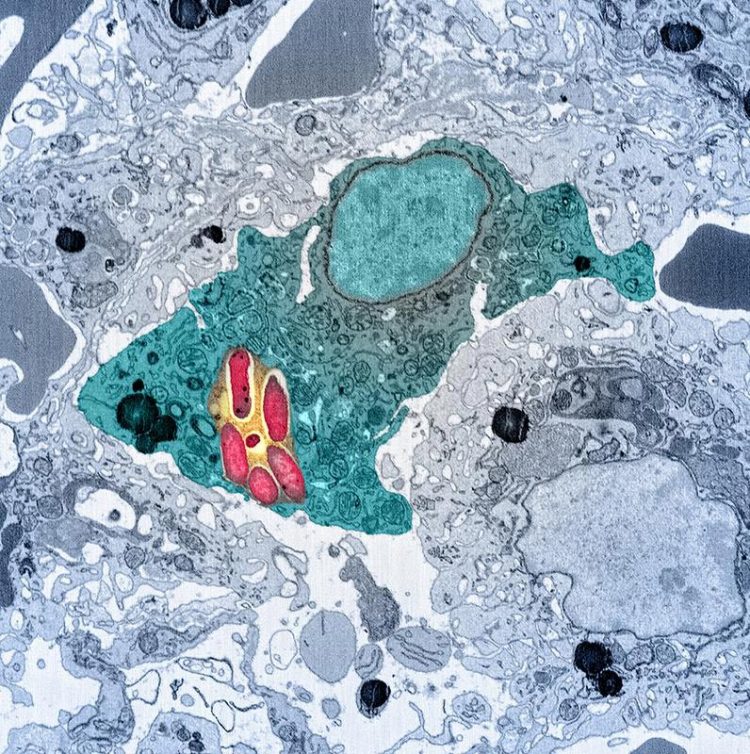Magnesium deprivation stops pathogen growth

Electron microscope image of a macrophage (blue) infected with Salmonella (red). University of Basel, Biozentrum
When pathogens infect an organism, the defense system immediately starts to fight the bacteria. To escape the patrolling immune cells, some bacteria invade and replicate inside host cells. However, the host has developed various strategies to keep the intracellular bacteria under control.
Olivier Cunrath and Prof. Dirk Bumann at the Biozentrum, University of Basel, have now discovered that magnesium is crucial for bacterial growth inside host cells. Magnesium starvation is a stress factor for the bacteria, which stops their growth and replication. The host cells limit magnesium supply to these intracellular pathogens using a transport protein called NRAMP1.
Host protein suppresses pathogens
In their study, the researchers investigated Salmonella, a bacterial pathogen that causes gastroenteritis and typhoid fever. The bacteria settle in small inclusions in the macrophages of the immune system. Whether and how quickly Salmonella replicate inside these vesicles and spread depends on the proper functioning of the NRAMP1 transporter.
“It has been known for decades that NRAMP1 makes the host more resistant, but how and why has remained unclear,” says Bumann. “We were greatly surprised to find that this transport protein pumps magnesium ions out of the vesicles and thus restricts Salmonella growth. This is a new and completely unexpected mechanism.”
Magnesium as an Achilles heel for bacteria
As magnesium is a central component of many metabolic enzymes, a shortage reduces bacterial metabolism and growth. “Magnesium seems to be the Achilles heel for intracellular pathogens. The less magnesium is available, the harder they try to get it. The bacteria go on alert and activate all magnesium uptake systems. Nevertheless, they do not manage to get enough,” says first author Cunrath. “However, if the pump in the host cells is defective, magnesium is available in sufficient quantities to enable rapid Salmonella growth.”
Transporter affects host resistance
The function of NRAMP1 determines host susceptibility to infections. Animals and humans with reduced NRAMP1 are more susceptible to various intracellular pathogens. If this transporter is completely absent, even a very small number of pathogens can cause a fatal infection.
Infections are always a race between the host and the pathogen. New drugs that would make it even harder for the bacteria to obtain magnesium, could slow down the pathogens even more and thus provide the host a decisive advantage in defeating the infection.
Prof. Dr. Dirk Bumann, University of Basel, Biozentrum, Tel. +41 61 207 23 82, E-Mail: dirk.bumann@unibas.ch
Olivier Cunrath and Dirk Bumann
Host resistance factor SLC11A1 restricts Salmonella growth through magnesium deprivation
Science (2019), doi: 10.1126/science.aax7898
https://doi.org/10.1126/science.aax7898
Media Contact
More Information:
http://www.unibas.chAll latest news from the category: Health and Medicine
This subject area encompasses research and studies in the field of human medicine.
Among the wide-ranging list of topics covered here are anesthesiology, anatomy, surgery, human genetics, hygiene and environmental medicine, internal medicine, neurology, pharmacology, physiology, urology and dental medicine.
Newest articles

A new puzzle piece for string theory research
Dr. Ksenia Fedosova from the Cluster of Excellence Mathematics Münster, along with an international research team, has proven a conjecture in string theory that physicists had proposed regarding certain equations….

Climate change can cause stress in herring larvae
The occurrence of multiple stressors undermines the acclimatisation strategies of juvenile herring: If larvae are exposed to several stress factors at the same time, their ability to respond to these…

Making high-yielding rice affordable and sustainable
Plant biologists show how two genes work together to trigger embryo formation in rice. Rice is a staple food crop for more than half the world’s population, but most farmers…



